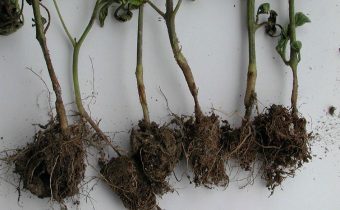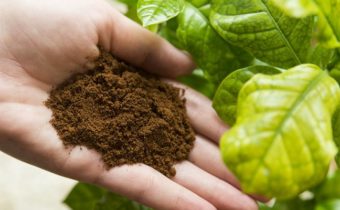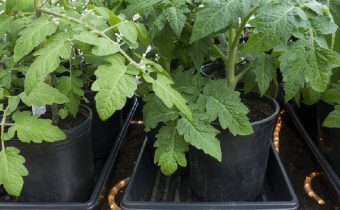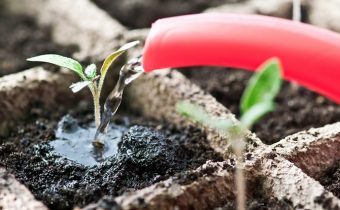Tomato Bonsai: a unique tree in your apartment
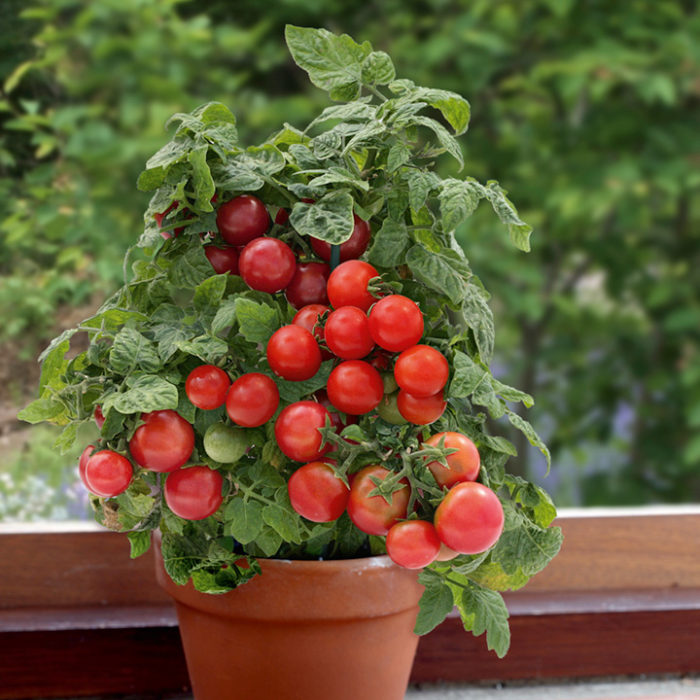
Official information
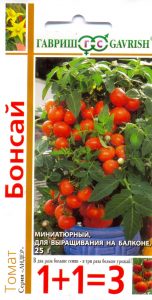 Applicant and originator of the variety Gavrish Breeding Company LLC, Moscow Russia. They submitted an application for admission to the register of breeding achievements for consideration in 1998, and in 2001 the variety was entered in the register under number 9806059.
Applicant and originator of the variety Gavrish Breeding Company LLC, Moscow Russia. They submitted an application for admission to the register of breeding achievements for consideration in 1998, and in 2001 the variety was entered in the register under number 9806059.
The registration commission allowed the variety to be used in all regions of the Russian Federation, and “Bonsai” is recommended as an early maturing one for cultivation in room conditions, on balconies and loggias.
Characteristics and description
The ripening of the indoor fruits begins at 95-97 days after the moment when all the sown live seeds have fully grown.
The vegetative form of the tomato does not exceed 50 cm, the plant is determinant and is independently formed as a stem.
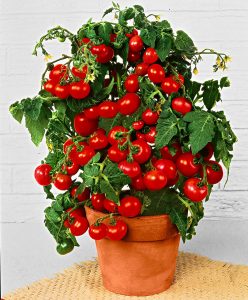 The leaf plate is medium in size, dark green and slightly wrinkled. The inflorescence begins to be laid over the 6-7 leaf, and further the separation by the leaf no longer occurs. The inflorescence is of intermediate type.
The leaf plate is medium in size, dark green and slightly wrinkled. The inflorescence begins to be laid over the 6-7 leaf, and further the separation by the leaf no longer occurs. The inflorescence is of intermediate type.
Fruit "Bonsai" round, smooth, glossy. The color is bright red. The mass of the ripened fruit varies in the range of 25-30 g. Cutting a tomato, you can see two seed nests with small seed.
The tasting evaluation by the commission is “excellent”. Those who grew a tomato of this variety fully agree with this assessment. Tomatoes are pleasant, not firm and rather dense. To taste, the fruits make it possible to understand that this is the most delicious tomato that you have been dreaming about all winter, but with Bonsay you can even afford the luxury of taste in January.
Growing a Bonsai tomato reviews, photos, yields can be considered firsthand, but the register of varieties indicates that each bush produces 1 kg of high-quality fruit.
Disease and Pest Resistance
None of those who have already grown a variety, do not give information about any nuances with diseases and pests.
It makes no sense to process the plant for no apparent reason, and maintaining optimal conditions will provide the variety with strong immunity.
Advantages and disadvantages
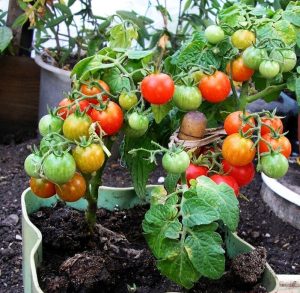 For those who want to decorate their home and have a harvest, the variety "Bonsai" is the most suitable, given its number of advantages:
For those who want to decorate their home and have a harvest, the variety "Bonsai" is the most suitable, given its number of advantages:
- easy to grow;
- suitability for rooms, loggias, balconies;
- no need for garters and supports;
- great taste;
- high commercial quality podov.
Reviews of vegetable growers and those who decorated their homes with pots with tomatoes, instead of flowers, are unanimous - the variety is excellent for indoor conditions and has no disadvantages.
Features of growing varieties
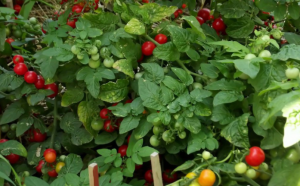 When growing tomato in a room, you need to consider that it needs:
When growing tomato in a room, you need to consider that it needs:
- south window (in a pinch, east);
- pot with a capacity of at least 1 liter;
- nutrient soil;
- backlight (if the cultivation will fall for the winter months).
The same requirements are put forward for balconies and loggias.However, in this case it is still necessary to maintain the temperature.
If with the direction of light and temperature indicators, everything is clear, then the pot needs to be purchased. Plants in old pots, cans and other utensils look ridiculous. The ceramic pot will be the best “home” for a tomato, but plastic flower pots will also work.
See also: Tomato "Cardinal": characteristics and description of the variety
Soil preparation
Nutritious soil can be purchased at a flower shop or garden center. Universal soil is quite suitable for the cultivation of tomato. The primers prepared by agrarians have a number of advantages:
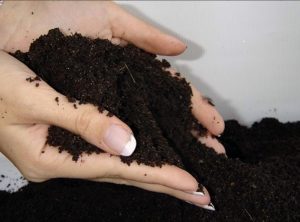
- they are nutritionally balanced;
- have a balanced acidity;
- matched by permeability;
- structured by air permeability;
- do not require additional enrichment fertilizers.
If you decide to make a soil mix yourself, then it should consist of:
- fresh compost;
- garden land (one on which no solanaceous crops were grown);
- ripened humus;
- coarse sand.
The proportions of the components should be 1: 1: 1: 0.3. To a bucket of this mixture you need to add 1 tbsp. spoon of superphosphate and 1 tbsp. spoon of ammonium nitrate. The mixture is prepared in advance, to give the opportunity to mature. The best time for aging is 5-6 months (we are preparing from autumn, for use in spring). If this opportunity is already missed, then at least 2-3 weeks.
Growing seedlings
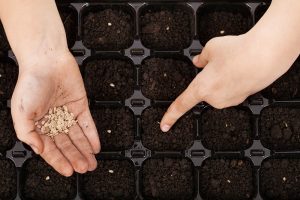 In order not to grow seedlings more than necessary is determined in advance with the amount, given that one plant will grow in one pot. If cultivation will take place on a loggia or balcony in the same container, then the distance between plants should be 30–35 cm. Based on this, the number of seeds for sowing should be calculated.
In order not to grow seedlings more than necessary is determined in advance with the amount, given that one plant will grow in one pot. If cultivation will take place on a loggia or balcony in the same container, then the distance between plants should be 30–35 cm. Based on this, the number of seeds for sowing should be calculated.
By purchasing seeds it is impossible to accurately calculate how many of them are sown, since we cannot be sure of germination. In order to sow precisely (however, a reserve of 1-2 is needed in any case) the seeds can be put on a saucer in which to pre-place filter (toilet) paper soaked in warm water. You need to put the saucer in a plastic bag and place it in a warm place.
Sowing
To grow seedlings there is no need to sow each seed in a separate large pot. Until fruiting, sprouts will look lonely and ridiculous. It is better to sow all the seeds in one container.
We fill the flower pot in this order:
- At the bottom of the flower pot lay drainage (broken shards of pottery, expanded clay);
- Sand (layer 1 cm);
- The soil mix is 2/3 of the pot height.
Care
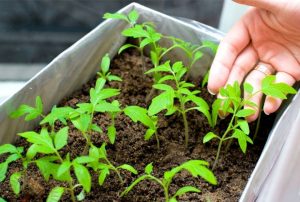 Before germination, the temperature should be maintained within 24-26 C day and night. Shoots will appear in 4-5 days. As soon as all the seeds grow, we lower the temperature during the day to 18-20 ᵒC, and at night to 14-16 ᵒC. Creating coolness will help the seedlings not to stretch and their shoots will be stocky.
Before germination, the temperature should be maintained within 24-26 C day and night. Shoots will appear in 4-5 days. As soon as all the seeds grow, we lower the temperature during the day to 18-20 ᵒC, and at night to 14-16 ᵒC. Creating coolness will help the seedlings not to stretch and their shoots will be stocky.
At this moment it is necessary to have a very bright room or additional lighting of shoots with special phyto lamps.
Watering is carried out with warm water (2-3 ° C above room temperature). Watering with cold water can lead to fungal disease, black leg.
Water for irrigation is better to take rain, snow or settled.
If the soil mixture is prepared correctly, then there is no need for dressing during the period of growth of seedlings.
As shoots grow, soil mix is constantly added to them. Thus, the pot is filled almost to the top.
Transplant to a permanent place
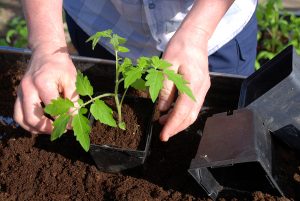 Usually seedlings are seated in the phase of two true leaves. However, when grown on a windowsill, it is better to wait for the moment when the bushes will come into contact with each other with leaves, and already in this case, plant in separate pots.
Usually seedlings are seated in the phase of two true leaves. However, when grown on a windowsill, it is better to wait for the moment when the bushes will come into contact with each other with leaves, and already in this case, plant in separate pots.
We fill the containers in the same way as for growing seedlings. Tomato sprout taken out of the common pot, if possible without destroying earthen room.
In the center of the pot, we make a recess and plant a tomato bush there, deepening it along the cotyledon leaves. Sprinkle the rhizome and compact the soil.
Growing in a greenhouse
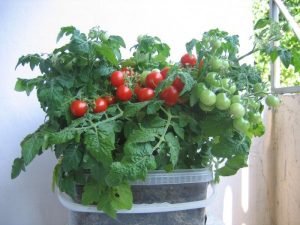 If we consider this variety for a greenhouse, then planting it in beds is not profitable, since the yield is not high and the greenhouse itself will be empty.
If we consider this variety for a greenhouse, then planting it in beds is not profitable, since the yield is not high and the greenhouse itself will be empty.
Planting varieties in hanging pots or on greenhouse shelves in pots is another matter entirely.
If cultivation is carried out in pots, they are suspended so that at least 60 cm is left on the ceiling, since the variety is stem and will not hang down.
If the greenhouse is equipped with side shelves, in one or several rows, then pots with seedlings or plants already planted alone are installed on them. In this case, you need to take into account the nuance that the tomato bush should not touch the film. Since it can form condensate, which is the environment for the development of microscopic fungi.
Growing up on the balcony
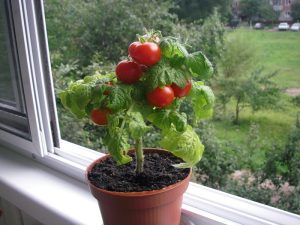 If the balcony is fully glazed and insulated, then by choosing a Bonsai tomato, cultivation on the balcony can be started in April. Seedlings should be grown in the same pot in room conditions, having sown in March, and then plant the plants in individual pots and put them on the balcony window sills and shelves.
If the balcony is fully glazed and insulated, then by choosing a Bonsai tomato, cultivation on the balcony can be started in April. Seedlings should be grown in the same pot in room conditions, having sown in March, and then plant the plants in individual pots and put them on the balcony window sills and shelves.
As with growing in greenhouses, you can put pots on the balcony not only on window sills, but also on fitted shelves, shelves, and hanging pots.
If the balcony faces south, then you should take care of shading, because the heat adversely affects the plant.
See also: The best varieties of tomatoes for open ground
Care
Wherever it is decided to grow tomato varieties "Bonsai" he will need:
- watering;
- top dressing.
The multiplicity of irrigation is selected depending on the temperature, light, humidity. Leaves will help determine the optimality. If they are elastic, bright, then the plant feels good. If the turgor of the leaves is lost, and they look privyashih, then moisture supply is not enough.
Top dressing
For successful fruiting and a beautiful type of plant form, fertilizing with complex preparations is necessary.
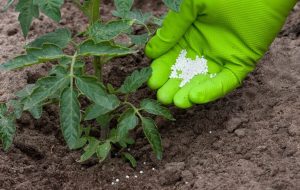 2 weeks after transplantation in individual pots, tomatoes need to be fed with nitrogenous solutions. To do this, dissolve 3 g of ammonium nitrate in a liter of water and pour 100 ml under each bush.
2 weeks after transplantation in individual pots, tomatoes need to be fed with nitrogenous solutions. To do this, dissolve 3 g of ammonium nitrate in a liter of water and pour 100 ml under each bush.
The second feeding is carried out in 2 weeks. 3 g of potassium sulfate should be dissolved in one liter of water and 100 ml should also be poured under each bush.
After another two weeks, re-feeding. In a liter of water we dissolve 3 g of superphosphate and add 100 ml to each pot again.
Such alternation will help the plant to be strong, dense and in time to lay flower brushes.
Shops for gardeners offer universal fertilizers for feeding plants in each growing season. They are balanced not only in macroelements, but also in micro, which is very important for growing tomato in a limited space.
Formation and possible nuances
Tomato "Bonsai" refers to those varieties that form themselves. He does not require your attention. There is no need to pinch and tie up, as well as install supports and all kinds of clamps.
See also: Tomato "Black Cluster F1" - do I need a garden?
The plant form, if all agrotechnical measures are carried out correctly, looks like a small tree hung with red fruits. However, if the illumination was not enough, the bushes can reach for the light and will be higher than genetically incorporated. In this case, in order to avoid breakages of the shoots, it is necessary to establish a support and tie up the stretched processes.
Growing "Bonsai" you get the beauty and harvest.
Video: 10 mistakes when growing tomatoes


